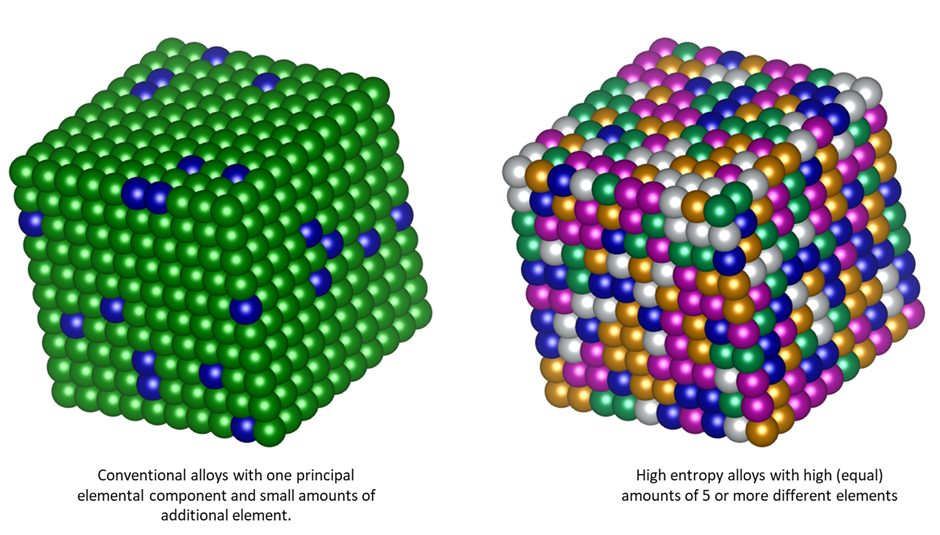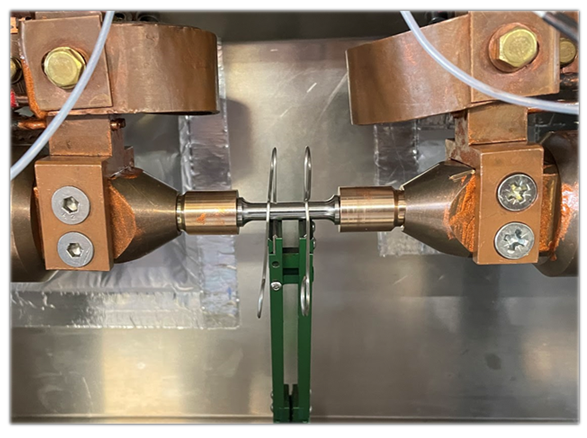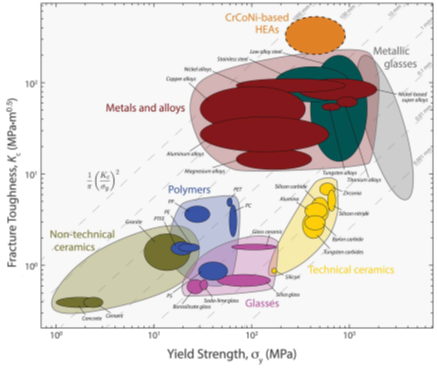Most metals are more likely to crack as you lower the temperature, but a global research collaboration has been studying alloys that do the exact opposite. The subject of their investigation were high and medium entropy alloys that actually get less likely to crack as they get colder.
Unlike traditional metal alloys such as steels, which are mainly made up of one element with others added in small amounts, high and medium entropy alloys have multiple principal elements in almost the same amount, as shown in the diagram below. Designing new alloys in this way from combining elements in different ways leads to new materials with unique properties. This approach opens up endless possibilities on how different combinations of elements can be mixed and new alloys can be arrived at. Therefore, finding a good alloy is like finding a needle in a haystack.

A unique property of one such family of alloys is the ability for the materials to get stronger and less likely to crack at lower temperatures. This is the complete opposite of the behaviour of most metals, which normally get stronger but more brittle at low temperatures. Alloys derived from the combination of chromium (Cr), cobalt (Co) and nickel (Ni) have been shown to have this special property, maintaining their resistance to fracture even down to -253°C.
Being able to create materials that remain strong at these very low temperatures is extremely useful for applications such as transporting liquid hydrogen as a method of energy transport in a hydrogen-based economy, or in creating materials that can be used in space or on other planets.
 In this study, published in Science, the unique setup of the Engin-X beamline at ISIS neutron facility enabled researchers to study the mechanical properties of Cr-Co-Ni medium entropy alloys at liquid hydrogen temperatures. “The ability to mechanically test materials at temperatures as low as -253°C is extremely unique. At ISIS we have the specialized equipment that can do just that while also collecting diffraction data in situ," said Dr Saurabh Kabra, co-investigator and group leader of the engineering and imaging group at ISIS. The experimental setup for mechanical testing is shown on the left.
In this study, published in Science, the unique setup of the Engin-X beamline at ISIS neutron facility enabled researchers to study the mechanical properties of Cr-Co-Ni medium entropy alloys at liquid hydrogen temperatures. “The ability to mechanically test materials at temperatures as low as -253°C is extremely unique. At ISIS we have the specialized equipment that can do just that while also collecting diffraction data in situ," said Dr Saurabh Kabra, co-investigator and group leader of the engineering and imaging group at ISIS. The experimental setup for mechanical testing is shown on the left.
The study, which involved senior researchers from an international collaboration including Professor Rob Ritchie (Lawrence Berkley National Laboratory), Professor Easo George (Oak Ridge National Laboratory), Dr Dong Liu (University of Bristol) and Dr Bernd Gludovatz (University of New South Wales), found that the Cr-Co-Ni-based alloys were extremely tough, with their resistance to both crack-initiation and growth at the lowest temperatures being amongst the highest ever recorded, as shown in the diagram on the right, below.
 By using neutrons and electron microscopy to study the microstructure around a deliberately initiated crack, they were able to determine what was happening at the atomic and grain scale that caused this impressive toughness. They found a variety of mechanisms occurring at different stages of crack growth. These are the same mechanisms that are responsible for other important material properties like strength and ductility.
By using neutrons and electron microscopy to study the microstructure around a deliberately initiated crack, they were able to determine what was happening at the atomic and grain scale that caused this impressive toughness. They found a variety of mechanisms occurring at different stages of crack growth. These are the same mechanisms that are responsible for other important material properties like strength and ductility.
In high entropy alloys, by adjusting the elemental ratios, materials can be designed with exactly the right amount of strength, toughness and ductility that makes them suitable for specific applications.
Further information
As well as the published article, at DOI: 10.1126/science.abp8070, A perspective from Zhang and Zhang can be found at DOI: 10.1126/science.adf2205.
